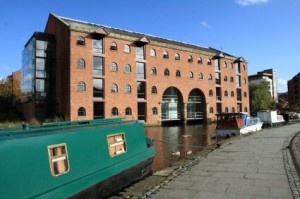
A warehouse in Castlefield (Manchester) converted into apartments and offices
Throughout the United Kingdom, developers are finding new uses for disused buildings and spaces. From hotels and farm buildings to warehouses and factories, properties are being transformed and refurbished into state of the art office and commercial space. Similarly, former office and industrial properties are being converted into residential spaces. One of the most famous conversions in the United Kingdom is the adaption of the Bankside Power Station in London into the Tate Modern.
About Converted Office Space
Converting existing buildings into new uses can help redefine a space, as well as the character of the neighbourhood it occupies. Converted office spaces are found in barns in rural areas, former industrial buildings in city centres, and converted churches. While the character of the structure can be maintained, converted office spaces provide tenants with the same amenities and services as a new build. For example, developers can introduce new information and communications technology, reliable security systems, and interiors with modern office services including meeting rooms and employee services such as cafes.
The Advantages of Converted Office Space
Converting barns, churches, hotels, industrial buildings and other properties is often an alternative to demolition. Reusing and re-purposing properties also provides an opportunity for developers and communities to preserve historic structures. Many times, historic buildings that are ideal for office conversion are found in city centres and can offer tenants convenient locations for doing business. They also provide developers unique opportunities to infuse heritage features with contemporary designs, often leading to landmark properties that convey innovation and creativity.
Converting buildings into office space can be a cost-savings measure and cost less than developing a new site. In most cases, fewer resources and materials are needed to convert an existing property when compared with constructing a new building. Larger, more expensive construction machinery is not typically needed when renovating buildings. Similarly, less labour is needed, which can also contribute to lower costs. Adapting existing spaces into new uses is also a sustainable construction method, particularly when space is limited in dense urban areas.
The Disadvantages of Converted Office Space
Refurbishing properties into office space can also result in hidden costs when older properties have extensive decay or damage. Additional costs may also result in decontaminating certain sites, such as industrial properties. Significant investment may also be needed in order to ensure converted disused properties meet current building codes and regulations.
When choosing a potential site, the potential for contamination and the costs for decontamination should be considered. Properties with hazardous materials, including asbestos, may not be viable options for office conversion. The condition of the structure, such as the foundation and roofing, should be assessed in order to fully understand conversion costs prior to developing the site. In some cases, the level of decay as a result of neglect and disuse is so severe that properties cannot be repaired. When decay is too extensive, developers may not be able to renovate the property to a level that it meets building standards set by the government.
Considering renting converted office space? Prime Office Space has a few interesting options at the moment (November 2012):
A converted barn with exposed beam ceilings in Worcester;
A converted railway station in Stafford;
A converted church in Marylebone, London;
A converted factory in Tottenham, London;
A beautiful Grade II listed red brick church in Salford;
A converted railway warehouse in Derby.

